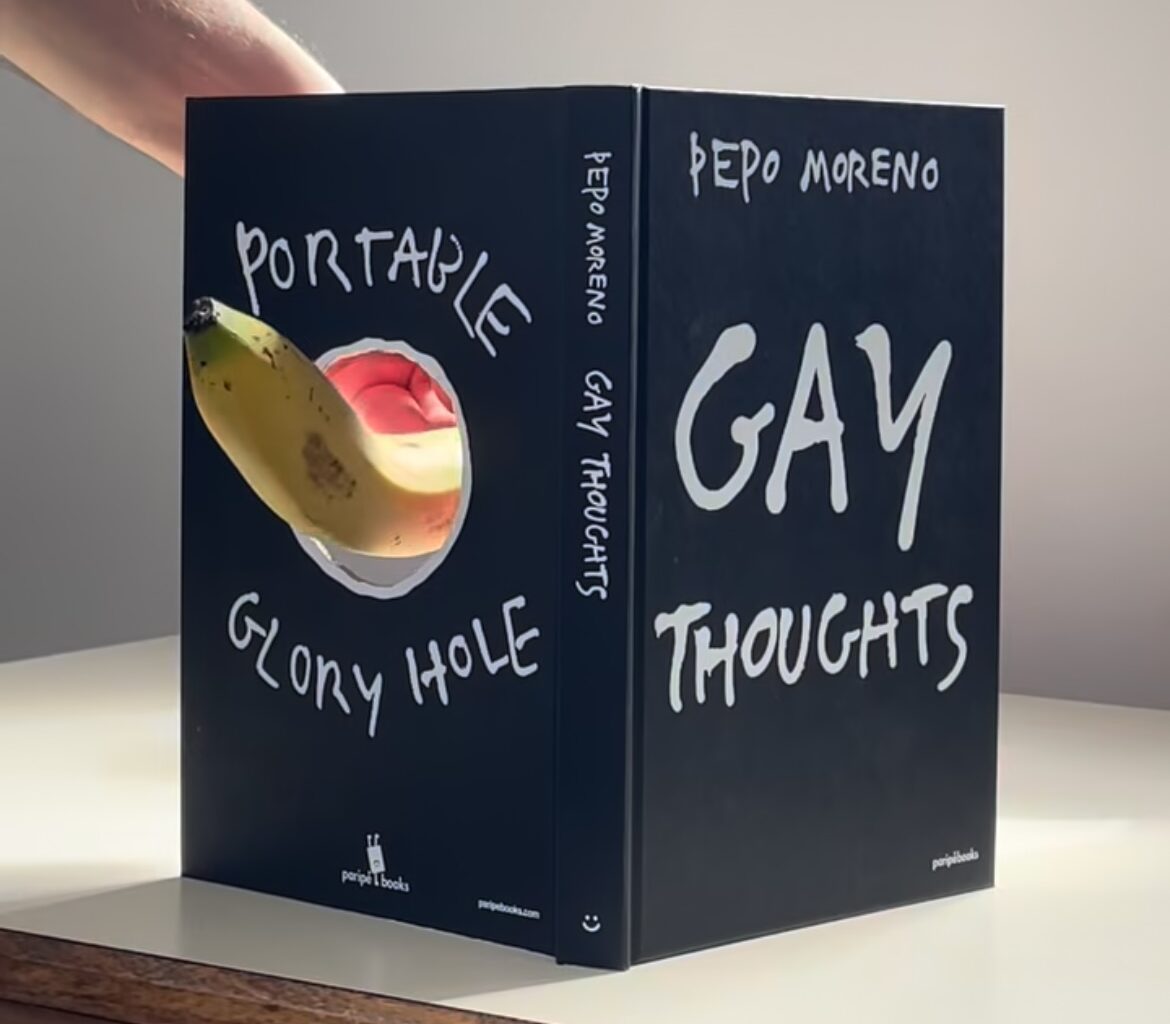GAY THOUGHTS
Pepo Moreno
Paripé Books, 2025
Pepo Moreno’s GAY THOUGHTS opens with a scribbled bookplate: “THIS BOOK BELONGS TO __________,” followed by “AND ITS” crossed out and replaced with “A PANSY OBVIOUSLY.” Then, later in the front matter: “SLUT.” All before the introduction.
Moreno wants to tease the reader. The Spanish-born painter has made a career of what editor and novelist Vicente Ferrer calls in his introduction “a mock and a celebration of gay stereotypes” expressed in playful visuals that trick readers into earnestness. The shallow reading of GAY THOUGHTS might mistake Moreno’s use of gay lifestyle tropes and internet vernacular (such as “I AM HOMIE SEXUAL” and “POWER BOTTOM AUTUMN”) as the book’s content—but these are the medium, not the message. Ferrer dubs these phrases, which are chopped and screwed into a collage of bitterness and sincerity, as “falsely superficial.” Millennial tenderqueer adspeak, or BuzzFeed Dada: this is the only vocabulary to stage the specific and eternal tensions between and within gay men. Approaching GAY THOUGHTS as a polyvocal text—a collective consciousness—the resultant ensemble of voices is not the Gay Men’s Chorus singing Broadway standards in harmony, but the thorny chatter of parasocial infighting, backhanded compliments lobbed across a Hell’s Kitchen dance floor.
Moreno’s previous art book, THIS IS A GAY BOOK, considers what exactly unites a gay community wherein the ties that bind are often arbitrary. Constituted of hand-painted memes, the earlier book haphazardly classifies: one page reads, “BJÖRK’S SWAN DRESS IS GAY,” the text disjointed by an impastoed portrait of the singer on the red carpet. THIS IS A GAY BOOK labels—outs?—with confidence, without consequence.
By contrast, GAY THOUGHTS operates with uncertainty toward any culturally-prescribed way of life and claims no single gay doctrine. Austere, it is mostly text, with each page a print of an original hand-inked phrase. The few intermittent doodles that do appear are morose and grayscale: a smiling face pocked with black tears, captioned “SAFE SPACES DON’T EXIST I GUESS.” These are psalms of desire, a sometimes illuminated manuscript dictated by the homosexual id and divinely inspired by dovetailing forces of rainbow capitalism and third-wave gay liberationism. Four consecutive pages each proclaim a series of “gay urges”: “BURNING EVERYTHING AND MOVE HAVING THIS BOOK”; “TAKING A MIRROR SELFIE AFTER THE GYM”; “BUYING EXPENSIVE COFFEE”; “DYEING YOUR HAIR AFTER A MINOR INCONVENIENCE.” By his last adage, Moreno’s pen is skipping—out of ink and so out of energy in regurgitating clichés based, embarrassingly, in truth.
Psychodynamics manifest in the subtle intentionality of Moreno’s longhand, or the drama of its error—scribbled, crossed out, almost-obscured false-starts and Freudian slips. One must approach each page not just semantically but compositionally and graphologically; an almost paranoid attention to slant, pressure, and word and line spacing is required in parsing each quippy maxim, playing dumb to closet its profundity. Outed, with effort, is a multitude of linework open to interpretive possibility. The ambling slant and light pressure of “BORN. GROW. POWER BOTTOM. DIE”—with pen strokes so skinny the words shrink from themselves—imply reticence, even shame; it is nothing like one bold and self-assuredly wide-spaced earlier page, “DON’T DISTURB I’M GAY CRYING,” ink-blotched to evidence emotion. Up to the very end (“THANKS FOR GETTING TO THE END DIVA”), modulations in pressure follow no traceable linear development. Rather, these mood swings seem to be guided by an erratic logic of “gay panic,” in both the archaic psychiatric denotation (non-functionality due to unrealized “gay urges”) and its common meme-ified sense (“yearning” for internet crushes and cartoon characters, which Moreno also does).

